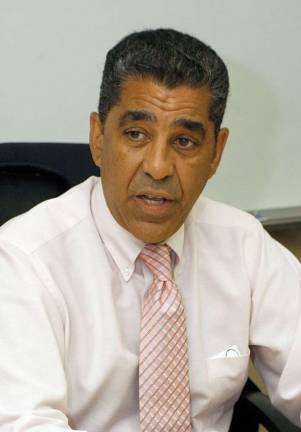Sen. Espaillat Hopes to Retain Expanded West Side District

As the September primary date draws near, Sen. Adriano Espaillat is pushing full steam ahead in his second consecutive campaign, hoping to convince a whole new set of voters that he is the right man to represent the 31st District in the New York State Senate for another term. Espaillat narrowly lost the congressional primary against incumbent Rep. Charles Rangel in June. The race went so far as a recount and showed that Espaillat, a relative newcomer up against an entrenched and embattled opponent, had come within hundreds of votes of winning and had rallied a lot of support in the district. When he lost, however, he turned his focus back to the state Legislature, and now he's running to retain the seat that he's only filled for a single term. "I think I come out of this strengthened, and having touched base with voters on a regular basis from January until now is never a bad thing," Espaillat said of his experience pivoting from a congressional race back to the state level. "It keeps your feet on the ground, it keeps your feet to the fire." He's spent a lot of time in the past year talking to voters, though now his focus is shifted from a larger and majority Hispanic district to a newly drawn and smaller area. The 31st Senate District used to stretch up into a chunk of the South Bronx, cover Washington Heights and run down the westernmost side of Manhattan, but its boundaries have moved south and very slightly east, making a bigger part of the Upper West Side Espaillat's territory. "A greater portion of the West Side was brought in, in a funny sort of gerrymandered way. It's called the spaghetti district," Espaillat said, referring to a thin strip that snakes across 38th Street to Seventh Avenue, then down to 30th Street between Seventh and Eighth avenues, then back west across to 10th Avenue and down to West 24th Street. It gives the district a very tiny slice of several different neighborhoods, but Espaillat said that despite the head-scratching methodology involved in creating it (he pushed for independent redistricting), he is looking positively at this new district. "Rather than having a whole area, you have different pieces of blocks. I've made my way over there, and I've gotten to meet people in the new part of the district," he said. "It's kind of exciting because it goes all the way down to the 20s. [There's] all of Madison Square Garden, parts of Hell's Kitchen, Chelsea." While the racial demographics haven't changed too much-the old district was 57 percent Hispanic, 30 percent white and 7 percent black, while the new district is 56 percent Hispanic, 29 percent white and 8 percent black-the race is different from the last time Espaillat ran for the seat in 2010. He's vying for votes from wealthy Riverside Drive enclaves as well as working-class families in Washington Heights, but he said that many issues are similarly pressing to all of his potential constituents. Some of the diversity of concerns within the district can be a good thing, he said. "Hydrofracking, which I'm very much opposed to, has a very strong interest on the West Side. I'm trying to get the northern part of the district more aware of that." Espaillat will be on the Democratic primary ballot against State Assembly Member Guillermo Linares, who currently represents the 72nd District in Washington Heights. Mark Levine, who has planned to run for the seat with Espaillat's endorsement, stepped down and is now running for City Council instead. "At the end of the day, I think I have a very strong record and I've worked very hard on the minimum wage bill, rent regulations, hydrofracking, the DREAM Act-important progressive issues," Espaillat said. The Democratic primary is on Tuesday, Sept. 13.